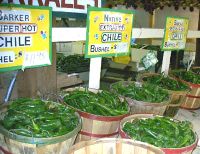Chile (Capsicum)
| New Mexico group 'Chile' | |
|---|---|

| |
| Freshly harvested chiles being sold by bulk | |
| Scientific classification | |
| Kingdom Information | |
| Domain | Eukaryota |
| Kingdom | Plantae |
| Subkingdom | Tracheobionta |
| Division Information | |
| Superdivision | Spermatophyta |
| Division | Magnoliophyta |
| Class Information | |
| Class | Magnoliopsida |
| Sub-class | Asteridae |
| Order Information | |
| Order | Solanales |
| Family Information | |
| Family | Solanaceae |
| Genus Information | |
| Genus | Capsicum |
| Species Information | |
| Species | Capsicum annuum L. |
| Binomial name | Capsicum annuum
"New Mexico group" |
| Synonyms | Chile pepper, Red chile, Green chile |
| Population statistics | |
| Conservation status | Domesticated |
The New Mexico chile pepper (plural chiles), also called Hatch chile or NuMex, and informally within the U.S. state of New Mexico, green chile and red chile. First grown by the Spanish and Pueblo Native Americans, and later by the Mexican and American territories. Chile is in the same family as the jalapeño, and other long peppers, but is a distinct and unique species with a distinct and unique taste. It is used ubiquitously in New Mexican cuisine as a spice and flavoring agent. It ranges from very mild to extremely hot. It comes in two varieties the unripe form of the plant called green chile and the ripened form of the plant called red chile, if both green chile and red chile are used it is referred to as Christmas (a reference to the color combination). It ranks as one of the most-important cash crops and culturally significant plants in New Mexico. It provides several vitamins, including Vitamin C and Vitamin A and other nutrients, which flourishes most adeptly in the high altitudes of New Mexico, and in the distinct four seasons and temperate climates within the state. It is usually grown along the Rio Grande river, however, New Mexico also has unique "land-race" peppers that are more adept at growing with lower water amounts.
This species of chile is only grown in the Rio Grande valley and is not used much outside of that region. It requires extremely dry and hot weather to grow. A unique species of bacteria attacks the plant, it is theorized that the unique chemical agent that gives chile its kick evolved in response to this bacterial agent. Hatch, New Mexico is the largest agricultural producer of chile and Hatch Chile is considered some of the best by chile aficionados.
The skin of the chile is tough so it is removed before consumption. It is also almost never consumed raw. Traditionally the chile is flame roasted and most commercial producers will flame roast it before freezing and packaging. The plant is harvested in October and is sold by the pound across the state from both road side stands and major commercial venues like Walmart. Chile roasters set up giant roasters outside of shops where consumers can have the chile roasted, usually free of charge. These roasting stations pop up all over the place during October so the smell of roasting chile is closely associated with fall in the state.
New Mexico chile is highly addictive, it is believed that the endorphins released in response to the spicy and pungent flavor is the source of this addiction. Regardless, those born and raised on chile can experience intense cravings and withdrawal symptoms if they stop consuming it. Chile is so popular that it usually must be included as a menu option at any restaurant in the state. It is used on hamburgers, pasta, omelets, sandwiches, soup, salad and hundreds of other traditional and non-traditional dishes, including even sushi. Franchise stores such as Subway and McDonald's get special permission from the franchise headquarters to include it on their menu as a local option.
